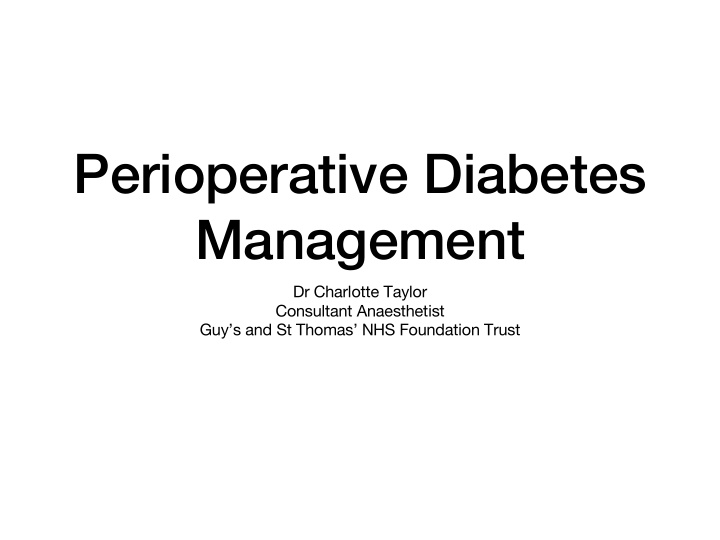



Perioperative Diabetes Management Dr Charlotte Taylor Consultant Anaesthetist Guy’s and St Thomas’ NHS Foundation Trust
• 4.7 million people in the UK with diabetes (9%) • 1 in 6 in-patients has diabetes • 13% PQIP population
PQIP report 8.5
PQIP report Recommended upper limit of HbA1c 8.5 (in %) for elective surgery 90
PQIP report Recommended upper limit of HbA1c 8.5 (in %) for elective surgery % of patient with poor glycaemic control 90 having elective surgery
PQIP report Recommended upper limit of HbA1c 8.5 (in %) for elective surgery % of patient with poor glycaemic control 90 having elective surgery 69
PQIP report Recommended upper limit of HbA1c 8.5 (in %) for elective surgery % of patient with poor glycaemic control 90 having elective surgery 20 69 % of patients with an HbA1c recorded
PQIP report Recommended upper limit of HbA1c 8.5 (in %) for elective surgery % of patient with poor glycaemic control 90 having elective surgery 69 % of patients with an HbA1c recorded % of patients having elective surgery 20 with poor glycaemic control
NCEPOD Enormous and unwarranted variation in the standard of care • Retrospective case note and provided to patients with diabetes questionnaire review who have had surgery. • 509 patients aged 16 and over who had type 1 or type 2 diabetes who underwent a Professor Ravi Mahajan -RCOA President surgical procedure
Pre-assessment • Individualised Perioperative diabetes plan • Perioperative drug changes • Fasting guidelines • Identify higher risk patients • Type 1 • Poor control
HbA1c HbA1c % 5 5.5 6 6.5 7 7.5 8 8.5 9 9.5 10 10.5 11 11.5 12 HbA1c 31 37 42 48 53 59 64 69 72 80 89 91 97 102 108 mmol/mmol 69 (8.5%) = 10.9mmol/l Estimated average 5.4 6.2 7.0 7.5 8.6 9.4 10.1 10.9 11.7 12.5 13.3 14.0 14.9 15.7 16.5 blood glucose
New(er) Drugs • Sodium Glucose cotransporter 2 inhibitors (GLT2i) • Gliflozins • Dipeptidyl Peptidase-4 inhibitors (DPP4i) • -gliptins • Increatin mimics • e.g. extenatide
Analogue insulins • Ultra short acting • Long acting • Fiasp (insulin aspart) • Levemir (insulin detemir) • Short acting • Lantus (insulin glargine) • Novorapid (insulin aspart) • Ultra long acting • Humalog (insulin lispro) • Tresiba (insulin degludec) • Apidra (insulin glulisine)
Admission • Do not change solely due to diabetes • Avoid Carbohydrate loading drinks in Type 1 ( and possibly insulin treated type 2)
Avoid Variable Rate Intravenous Insulin Infusion wherever possible
Management of Hyperglycaemia
Management of Hypoglycaemia
“The most conclusive way to find out if a patient is type 1 or type 2 is to not give them insulin. Type 1 diabetics MUST have insulin If they die they were type 1”
New Technologies
Key takeaways • Hospital-wide guidelines • Create an individualised plan for your patient and communicate it • Avoid VRIII wherever possible • Make sure Type 1s receive insulin • Monitor the patient’s blood sugar
Further Reading • Management of adults with diabetes undergoing surgery and elective procedures: Improving standards http://www.diabetologists- abcd.org.uk/JBDS/Surgical_guidelines_2015_full_FINAL_a mended_Mar_2016.pdf • Highs and Lows, NCEPOD London 2018 https://www.ncepod.org.uk/2018pd/Highs%20and%20Low s_Full%20Report.pdf • National Diabetes Inpatient Audit, England and Wales, 2017 https://files.digital.nhs.uk/pdf/s/7/nadia-17-rep.pdf
Recommend
More recommend